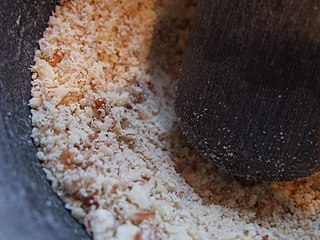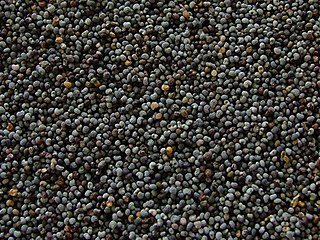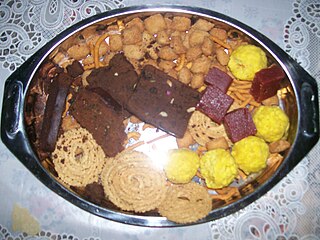Aboukir almond is a variety of candy or sweet made of almond-filled and sugar-coated marzipan. [1] These almonds are produced in the region of Aboukir in Egypt. The sweet is made with whole almonds that are blanched, then roasted and set aside. More almonds are then made into a paste and coloured green or pink. It is pressed into a ball or an oval. It is kirsch flavored and shaped in the form of a green almond and stuffed with a blanched roasted almond. The product is then dipped in hot sugar syrup and placed on parchment paper to dry. [2]

The almond is a species of small tree from the genus Prunus, cultivated worldwide for its seed, a culinary nut. Along with the peach, it is classified in the subgenus Amygdalus, distinguished from the other subgenera by corrugations on the shell (endocarp) surrounding the seed.

Catalan cuisine is the cuisine from Catalonia. It may also refer to the shared cuisine of Northern Catalonia and Andorra, the second of which has a similar cuisine to that of the neighbouring Alt Urgell and Cerdanya comarques and which is often referred to as "Catalan mountain cuisine". It is considered a part of western Mediterranean cuisine.

Marzipan is a confection consisting primarily of sugar, honey, and almond meal, sometimes augmented with almond oil or extract.

A macaron or French macaroon is a sweet meringue-based confection made with egg white, icing sugar, granulated sugar, almond meal, and, often, food colouring.

Frangipane, is a sweet almond-flavored custard, typical in French pastry, used in a variety of ways, including cakes and such pastries as the Bakewell tart, conversation tart, Jésuite and pithivier. A French spelling from a 1674 cookbook is franchipane, with the earliest modern spelling coming from a 1732 confectioners' dictionary. Originally designated as a custard tart flavored by almonds or pistachios, it came later to designate a filling that could be used in a variety of confections and baked goods.

Levantine cuisine is the traditional cuisine of the Levant, in the sense of the rough area of former Ottoman Syria. The cuisine has similarities with Egyptian cuisine, North African cuisine and Ottoman cuisine. It is particularly known for its meze spreads of hot and cold dishes, most notably among them ful medames, hummus, tabbouleh and baba ghanoush, accompanied by bread.

Valencian cuisine is a Mediterranean cuisine as cooked in the Valencian Community, Spain. Its basic ingredients are vegetables, seafood and meat. It is famous worldwide for its rices, such as paella, and its citrus fruits. The cuisine of neighbouring regions have given and received important contributions from Valencian gastronomy, amongst them Balearic cuisine, Catalan cuisine, Aragonese cuisine, Manchego cuisine and Murcian cuisine.

Almond meal, almond flour or ground almond is made from ground sweet almonds. Almond flour is usually made with blanched almonds, whereas almond meal can be made with whole or blanched almonds. The consistency is more like corn meal than wheat flour.
Canarian cuisine refers to the typical dishes and ingredients in the cuisine of the Canary Islands, and it constitutes an important element in the culture of its inhabitants. Its main features are the freshness, variety, simplicity, and richness of its ingredients, the mix of seafood and meat dishes, its cultural influences and the low knowledge of it by the rest of the world. Canarian cuisine is influenced by other cultures, especially that of the aboriginal inhabitants of the islands (Guanches), and has influenced Latin American cuisine.

Pastilla is a North African meat or seafood pie made with warqa dough (ورقة), which is similar to filo. It is a speciality of Morocco, Algeria, and Tunisia, where its variation is known as Malsouka. It has more recently been spread by emigrants to France, Israel, and North America.

Poppy seed is an oilseed obtained from the opium poppy. The tiny, kidney-shaped seeds have been harvested from dried seed pods by various civilizations for thousands of years. It is still widely used in many countries, especially in Central Europe and South Asia, where it is legally grown and sold in shops. The seeds are used whole or ground into meal as an ingredient in many foods – especially in pastry and bread – and they are pressed to yield poppyseed oil.

Kuswar or Kuswad is a set of festive sweets and snacks made and exchanged by Christians of the Konkan region in the Indian subcontinent for the Christmas season or Christmastide. These goodies are major parts of the cuisines of the Goan Catholic community of Goa, and the Mangalorean Catholic community of Karnataka. There are as many as 22 different traditional recipes that form this distinct flavour of Christmas celebration in Goa and Mangalore.

Gujhia, also known as Gughara, Pedakiya, Karanji, Kajjikayalu, Somas, and Karjikayi, is a sweet, deep-fried dumpling that is a popular dessert in the Indian subcontinent. This delicacy is made using either suji (semolina) or maida, which is stuffed with a mixture of sweetened khoa and dried fruits. The dumpling is then fried in ghee to give it a crispy texture.

The cuisine of Sardinia is the traditional cuisine of the island of Sardinia, and the expression of its culinary art. It is characterised by its own variety, and by the fact of having been enriched through a number of interactions with the other Mediterranean cultures while retaining its own identity. Sardinia's food culture is strictly divided into food from the land and food from the sea, reflecting the island's historical vicissitudes and especially its geographic landscapes, spacing from the coastline to the ragged mountains of the interior. The Sardinian cuisine is considered part of the Mediterranean diet, a nutritional model that was proclaimed by UNESCO as an intangible cultural heritage.

The milk-cream strudel is a traditional Viennese strudel and a popular pastry over Austria and many countries in Europe that once belonged to the Austro-Hungarian Empire (1867–1918). It is an oven-baked pastry dough stuffed with a filling made from diced, milk-soaked bread rolls, egg yolk, powdered sugar, butter, quark, vanilla, lemon zest, raisins and cream and is served in the pan with hot vanilla sauce.